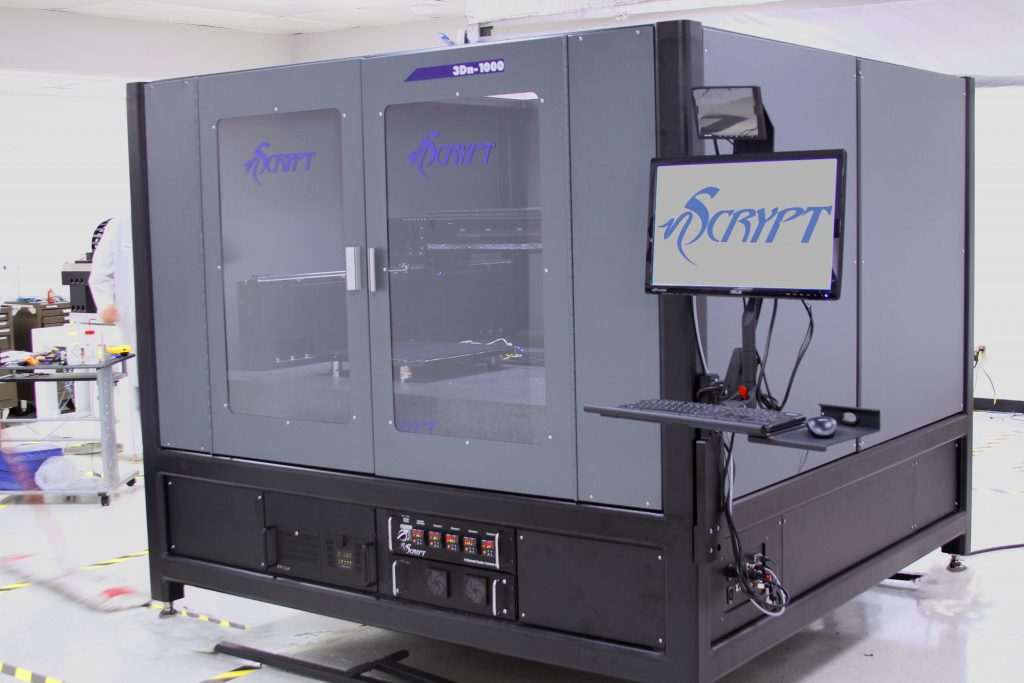Florida manufacturer nScrypt develops high-precision micro-dispensing and direct digital manufacturing equipment and solutions for a range of industries. Just a few months ago, its research and development think tank Sciperio, which specializes in cross-disciplinary solutions, was awarded a second phase contract from the US Air Force for its 3D printed conformal phased array antennas project. Now we’ve learned that together, nScrypt and Sciperio have secured a patent for large-scale precision manufacturing.
nScrypt is actually a spin-out company from Sciperio, which created technology that nScrypt commercialized under the Mesoscopic Integrated Conformal Electronics (MICE) program with the Defense Advanced Research Projects Agency (DARPA). Their new U.S. Patent No. 10,162,339 B2 for “Automated manufacturing using modular structures and real-time feedback for precision control,” which has 15 dependent and 3 independent claims, is for a scalable machine and process that will combine additive and traditional manufacturing processes for the fabrication of large, highly precise parts. nScrypt’s CEO Dr. Ken Church is the lead inventor, and his co-inventors are Engineering Manager and R&D lead Paul Deffenbaugh; Electrical Engineer Josh Goldfarb; Charles (Mike) Newton, who heads up nScrypt’s Cyberfacturing Center; and Mechanical Designer Michael Owens.
“We saw a need for a Direct Digital Manufacturing system that can make large parts with high precision and tight tolerances,” explained Dr. Church. “This patented system, which can be assembled from standard girders to make it scalable at a reasonable price, combines multiple motion control systems, computer control, and sensors that provide continuous feedback to tweak the 3D printing or traditional manufacturing process for large, high-precision parts.”
The patent, which was filed by Sciperio in April of 2016, is officially effective as of December 25, 2018, with the adjusted expiration date set as May 12, 2036.
Both the hybrid machine, and its new process, use either modular girders or a rigid frame, together with three motion systems controlled by a computer and coordinated by numerous sensors that offer continuous, closed-loop feedback in real time that allow for very small XYZ manufacturing adjustments. The system can be scaled from the smallest fraction of a meter up to hundreds of meters, thanks to the standard girders that make up the frame; this enables the manufacturing of precise, large parts at nanometer resolution.
The abstract for the patent states, “The first computer controlled motion system and the second computer controlled motion system use information from the plurality of sensors to assist in coordination between the first computer controlled motion system and the second computer controlled motion system.”
One of the motion control systems is in charge of how and when the gantry moves, while the second is in control of the movement of the part currently being built. The last motion control system runs an additional gantry, which holds either the traditional or the additive manufacturing tool head, depending on what’s being built. This second gantry actually rides on the first gantry, while a system controller uses data collected by the sensors to coordinate the multiple motion systems in real time. What’s interesting is that if these systems move out of place, they are able to adjust themselves back into the proper position.
“The implications of this are making large, very large and ultra large gantry or motion platforms that have very crude motion specifications (hundreds of microns to hundreds of millimeters) and adding a second fast gantry system with extreme precision (nanometers to microns) and using sensors to obtain large area prints with extreme precision tolerances in the prints, the milling, the polishing, the drilling, surface finishing, the additive, the subtractive or any part of an automated manufacturing process,” the patent reads.
 As for the elements that make up the machine itself, the motion sensors can be any mechanisms that are moved in the XYZ axes by computers, like ball screw drives, belt drives, and linear motor drives. The sensors can be acoustic, laser, optical, RF, or semi-conductive, while the tool heads for the machine can be for conventional manufacturing tasks like polishing, milling, and cutting, or 3D printing material extruders and micro-dispensing.
As for the elements that make up the machine itself, the motion sensors can be any mechanisms that are moved in the XYZ axes by computers, like ball screw drives, belt drives, and linear motor drives. The sensors can be acoustic, laser, optical, RF, or semi-conductive, while the tool heads for the machine can be for conventional manufacturing tasks like polishing, milling, and cutting, or 3D printing material extruders and micro-dispensing.
Discuss this story and other 3D printing topics at 3DPrintBoard.com or share your thoughts in the Facebook comments below.
Subscribe to Our Email Newsletter
Stay up-to-date on all the latest news from the 3D printing industry and receive information and offers from third party vendors.
Print Services
Upload your 3D Models and get them printed quickly and efficiently.
You May Also Like
Making Space: Stratasys Global Director of Aerospace & Defense Conrad Smith Discusses the Space Supply Chain Council
Of all the many verticals that have been significant additive manufacturing (AM) adopters, few have been more deeply influenced by the incorporation of AM into their workflows than the space...
EOS in India: AM’s Rising Star
EOS is doubling down on India. With a growing base of aerospace startups, new government policies, and a massive engineering workforce, India is quickly becoming one of the most important...
PostProcess CEO on Why the “Dirty Little Secret” of 3D Printing Can’t Be Ignored Anymore
If you’ve ever peeked behind the scenes of a 3D printing lab, you might have caught a glimpse of the post-processing room; maybe it’s messy, maybe hidden behind a mysterious...
Stratasys & Automation Intelligence Open North American Tooling Center in Flint
Stratasys has opened the North American Stratasys Tooling Center (NASTC) in Flint, Michigan, together with automation integrator and software firm Automation Intelligence. Stratasys wants the new center to help reduce...





































